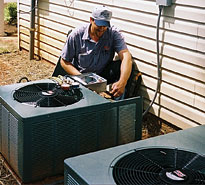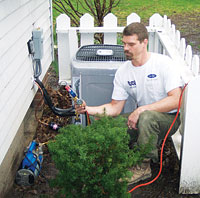
However, the quality of installation will definitely be an issue, especially if some contractors try to cut costs by offering only the outdoor unit during replacement jobs. Not only will system efficiency suffer, but its life span could also be shortened.
According to manufacturers interviewed by The News, the new coils' increased sizes could also make it tempting for contractors not to replace the indoor unit, especially if it means higher costs associated with modifying the plenum.
"New 13-SEER coils are going to be larger," said Tim Hawkins, engineering manager, residential air conditioning equipment, Rheem. "It's going to be extremely tempting to use the old coils. Ductwork is probably OK if it was done correctly the first time, but some adaptation might be necessary for the plenum." Some sheet metal work might be needed to do the job right.
The manufacturers also pointed out that refrigerant charge, line sizing, airflow, and overall system sizing will affect the performance of these higher-efficiency systems. If contractors are not used to installing efficiency upgrades, they may not take the steps they need to for optimum system performance and life span.

The Biggie: Larger Coils
"The most important thing is to ensure that the indoor and outdoor sections are designed to work together," said Steve Hancock of Trane. "That usually means that the whole system must be replaced rather than just the outdoor section, as is commonly done.""When replacing a heat pump, it is important that the contractor makes sure the indoor section is rated with the new heat pump," agreed Craig Kersten, senior product manager, Carrier.
"With today's higher-efficiency units, heat pumps are using more refrigerant, and if you do not have an indoor coil that is properly matched, you will have performance issues. These may include things such as charge imbalance, high-pressure switch trips, low comfort levels, and reliability issues."
Hawkins pointed out that safety agency (i.e., UL) approvals on heat pumps are for matched systems. "Using a nonmatched system will effectively void the safety agency approval on the replacement unit."
Indoor airflow over the coil is another important factor, he said. "Most new systems utilize larger indoor coils; 400 cfm/ton is no longer an adequate rule-of-thumb as it may have been in the past. A lower airflow rate is necessary for adequate moisture removal. I've found that 350 cfm/ton, sometimes less, is appropriate." It's best to consult the system's manufacturer.

Refrigerant And Lines
Refrigerant errors may result in a number of operational problems."It's easier to make an error in charging," said Hancock. "The higher-efficiency units will have a higher charge and liquid temperatures that are closer to the outdoor ambient. This means that a small error in the subcooling measurement can correspond to a big change in charge."
"Most of these systems will use TXVs instead of orifice devices," Hancock said. "Therefore, they must be charged to subcooling rather than superheat."
"R-410A systems are more sensitive to errors than R-22 systems because of the type of oil used in the system," Hawkins said. Moisture can create acid in these polyolester (POE) systems. The acid tends to eat away at compressor windings, causing compressors to fail.
"As we get closer to 2010, more systems will be using 410A. With R-410A systems, it will be even more critical for manufacturers to properly evacuate their units to remove the moisture since this has an increased effect on the reliability of the system.
"Existing lines may not be correct," he pointed out. "They don't wear out, and it's perfectly fine to leave them if they're the right size," Hawkins said. "Most manufacturers give some leeway on line size." If the lines are too large, however, there may be improper oil return to the compressor and an improper refrigerant charge.
"It will be critical for dealers to begin selling systems," said Andrew Fracica, York brand marketing manager, York Unitary Products Group. "At York, we have decided to offer our highest-efficiency heat pumps in R-410A. When replacing an R-22 system, dealers should consider replacing the entire system. Refrigerant oil incompatibility and coil surface area are just a couple of issues that must be addressed."

Load Calculations, System Corrections
According to Larry Banas, director of educational services for Emerson Climate Technologies, "Errors made in airflow, equipment sizing, and refrigerant charge will cause efficiency losses on higher-SEER units just as these same errors have caused efficiency losses in lower-efficiency units. Proper load calculation, system sizing, duct sizing, and refrigerant charge will continue to be just as critical on higher-SEER products."The question to ask is whether the original system was sized correctly. Also, did the homeowners make any significant changes to the home that would affect its load?
"Don't assume the existing system is sized properly and just replace it with the same size," warned Hawkins. "Improperly sized equipment results in an uncomfortable environment as well as inefficient operation. Perform a load study on the house. There's all kinds of things you can do to a house to make the load change. It's worse to be too large than too small.
"In a replacement application, dealers are usually hampered by the existing installation," observed Fracica. "There are many good installations out there where the dealer took the time to run a load calculation and properly size the equipment and ductwork; however, there are a number of equally bad installations where little or no scientific process was used to size, design, and install the system."
And if you won't do it for the benefit of the customer, at least do it to protect yourself. "It is important for dealers to take the time to do the load calculations if only to protect themselves," said Fracica.
"Another issue facing the dealer is duct leakage," said Fracica. "Older installations that were put in before new, stricter building codes may leak up to 20 percent or more of the total air volume, reducing efficiency and airflow to the space. In many cases, the ductwork is inaccessible and cannot be changed. These issues, however, need to be addressed by the dealer as best as possible."
Said Banas, "System ductwork size must be properly calculated to ensure correct cfm of airflow for proper temperature and humidity control."

Seasonal Implications
How can contractors prevent seasonal operational problems? Our pros recommended looking at the basics."It is strongly recommended that installers and servicepersons continue to diligently monitor voltage, amperage, superheat, and subcooling to minimize the probability of operational problems," said Emerson's Banas.
"If a heat pump fails to perform properly during the cooling season," he continued, "it will certainly fail to perform properly during the heating season. For example, if a heat pump is undercharged during the cooling season, the problem is compounded during the heating season."
"In a heat pump, the amount of refrigerant used for cooling is not the same during heating," stated Kersten. "Therefore, an improperly selected [coil] combination could result in reliability issues, discomfort, high-pressure switch trips, and performance issues. These things could all result in a higher cost to the customer."
Hancock explained how coil selection affects the charge and seasonal performance. "Most of a unit's charge is in its condenser. High-efficiency equipment typically has larger outdoor coils and higher refrigerant charge. In heating mode, this charge will go to the indoor coil since this is now the condenser," he explained.
"An older indoor coil is likely too small to handle all that charge; high head pressures and poor efficiencies will result," he said. "Similarly, charging an improperly matched system in heating mode can result in inadequate subcooling when that system goes into cooling mode."
"By far, the most critical aspect on heat pump replacement is the need to replace both the indoor and outdoor units and install a matched system specified by the manufacturer," stated Hawkins. "I can't stress this enough.
"The biggest problem is the refrigerant charge will not be correct for both cooling and heating modes. This will result in either excessively high pressure or inadequate subcooling level in one mode. Either situation will result in inefficient operation and premature failures." The compressor, he noted, could fail prematurely due to overheating, flooding, or bearing failure.
"If an installer chooses to only replace the outdoor unit and therefore doesn't have a matched system," continued Hawkins, "the charge level can be adjusted properly in either the cooling or heating mode, but will very likely not be correct in the other mode of operation. The same would apply if the installer only replaced the indoor unit."
Airflow could be another concern. "If the indoor airflow is inadequate," Hawkins said, "the system may operate OK in the cooling mode, but it could operate at excessive head pressure in the heating mode. This could cause nuisance tripping on the internal compressor protector or high-pressure control, as well as very inefficient heating season operation."
To Improve Installations
Doing it right the first time should always be the goal. Contractors who are less familiar with system efficiency upgrades may benefit by using checklists, double-checking manufacturers' installation data, looking closely at the existing system, and investing in training."Contractors and installers might want to make and follow a checklist to ensure nothing is overlooked," said Banas. "After startup of a new unit, the system pressures, temperatures, voltage, amperage, superheat, and subcooling should be checked to ensure proper operation.
"A next-day follow-up to check the system might be beneficial," he said. "Contractors should always refer to the manufacturer's product data sheets of tested combinations," said Kersten. "These can also be verified in the ARI directory of certified combination ratings."
Confirming key parameters is vital. "Confirm that indoor airflow is correct," said Hawkins. "Confirm the refrigerant charge is correct before you leave. Confirm the accuracy of the refrigerant line sizing. Confirm that electrical wiring and breakers are correct for the new unit. High-efficiency units tend to use less current, therefore they need a smaller fuse size. Installation instructions have that information with it."
Use the proper tools to take these measurements, he said. "Digital tools are excellent."
"It is important for the dealer to inspect the prospective job and offer options to the homeowner to correct any problems with the existing ductwork, electrical system, and refrigeration system piping, as part of the replacement process," pointed out Fracica.
Homeowner education is yet another critical portion of the installation process, and it is often missed by dealers, he added. "The dealer should take the time to explain the operation of the thermostat and provide a basic understanding of how the system works and what the homeowner should expect during normal operation.
"In addition, the dealer should explain the operation of any indoor air quality items associated with the system and point out the need to regularly change filters to keep the system operating at top efficiency." The contractor also needs to point out the importance of keeping bushes trimmed around the outdoor unit, and keeping leaves, debris, and snow cleared away.
Moreover, "The new unit may not act and sound exactly like the old unit," said Hawkins. "If a new thermostat is installed, it may not operate the same way as the old one."
"To improve installation skills, training is key," he continued. "Take advantage of any training that is provided."
"We highly recommend that each dealer attend training classes, particularly with regard to the new high-efficiency R-410A systems," said Fracica. In addition, "The dealer should follow the local building codes and the manufacturer's installation instructions.
"Doing so will ensure a proper installation, an efficient operating system, and a satisfied customer."
Publication date: 05/23/2005

Report Abusive Comment